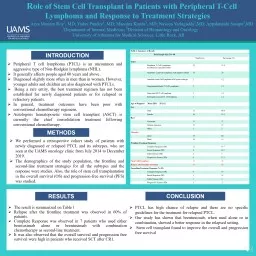

Lymphoma and Response to Treatment Strategies INTRODUCTION Peripheral T cell lymphoma PTCL is an uncommon and aggressive type of NonHodgkin lymphoma NHL It generally affects people aged 60 years and above ID: 908379
Download Presentation The PPT/PDF document "Ro le of Stem Cell Transplant in Patient..." is the property of its rightful owner. Permission is granted to download and print the materials on this web site for personal, non-commercial use only, and to display it on your personal computer provided you do not modify the materials and that you retain all copyright notices contained in the materials. By downloading content from our website, you accept the terms of this agreement.
Slide1
Role of Stem Cell Transplant in Patients with Peripheral T-Cell Lymphoma and Response to Treatment Strategies
INTRODUCTION
Peripheral T cell lymphoma (PTCL) is an uncommon and aggressive type of Non-Hodgkin lymphoma (NHL). It generally affects people aged 60 years and above .Diagnosed slightly more often in men than in women. However, younger adults and children are also diagnosed with PTCLs. Being a rare entity, the best treatment regimen has not been established for newly diagnosed patients or for relapsed or refractory patients. In general, treatment outcomes have been poor with conventional chemotherapy regimens.Autologous hematopoietic stem cell transplant (ASCT) is currently the chief consolidation treatment following conventional chemotherapy.
RESULTS
The result is summarized on Table 1Relapse after the frontline treatment was observed in 60% of patients.Complete Response was observed in 7 patients who used either brentuximab alone or brentuximab with combination chemotherapy as second-line treatment. It was also observed that the overall survival and progression free survival were high in patients who received SCT after CR1.
CONCLUSION
Arya Mariam Roy1, MD; Yadav Pandey1, MD; Manojna Konda2, MD; Naveen Yarlagadda2,MD; Appalanaidu Sasapu2,MD 1Department of Internal Medicine; 2Division of Hematology and Oncology University of Arkansas for Medical Sciences, Little Rock, AR
PTCL has high chance of relapse and there are no specific guidelines for the treatment for relapsed PTCL. Our study has shown that brentuximab, when used alone or in combination, showed a better response in the relapsed setting. Stem cell transplant found to improve the overall and progression free survival
METHODS
We performed a retrospective cohort study of patients with newly diagnosed or relapsed PTCL and its subtypes, who are seen at the UAMS oncology clinic from July 2014 to December 2019. The demographics of the study population, the frontline and second-line treatment strategies for all the subtypes and the response were studies. Also, the role of stem cell transplantation in the overall survival (OS) and progression-free survival (PFS) was studied.
Table 1: Summary of Results
Total Sample Size (N)= 48 Number (n) Percentage (%)Types Peripheral T- Cell Lymphomanot otherwise specified (NOS)2245.8 Anaplastic Large Cell Lymphoma ALK-negative subtype1429 Anaplastic Large Cell Lymphoma ALK-positive subtype24.2 Angioimmunoblastic T-Cell Lymphoma24.2 Extra nodal NK/T cell lymphoma24.2 Enteropathy associated T- cell lymphoma24.2Age at Diagnosis Mean (SD): 58 (2.1)Sex Male3266.6 Female1633.3Race Caucasian3573 African American1225 Other12Mortality Alive2960 Dead1940Frontline Treatment Response Complete Response (CR)2143.7 Partial Response (PR)918.7 Stable Disease (SD)24 Progressive Disease (PD)612.5Stem Cell Transplant1328Relapse after frontline treatment2460Secondline Treatment Response (N=20) Complete Response (CR)945 Partial Response (PR)525 Stable Disease (SD)15 Progressive Disease (PD)525